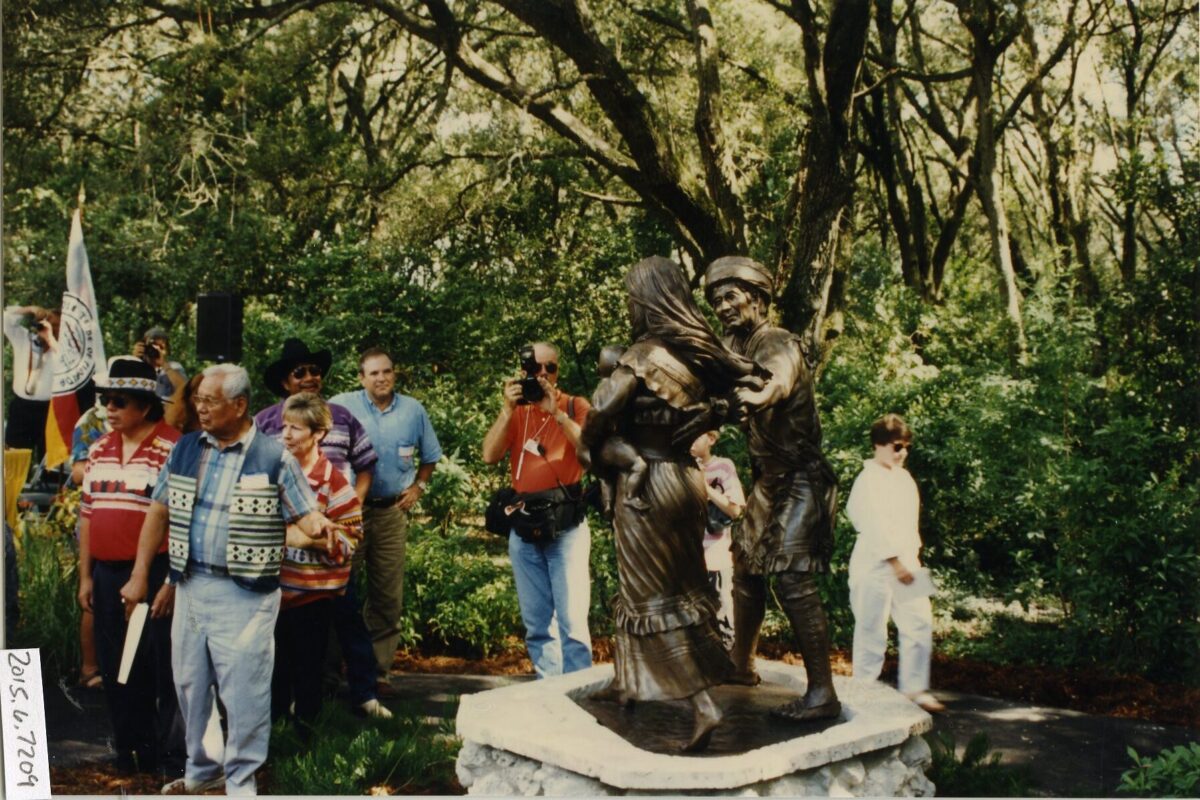
The Devil, Abiaka: The Legacy of Sam Jones
Recently on the blog, we have been exploring the history and cultural impact of historic Seminoles over time. This week, join us to learn about the life and legend of Abiaka. Also known as Abiaki, Arapeika/Aripika, Sam Jones, or just “The Devil,” Abiaka was a fierce Seminole wartime leader, medicine man, and spy. Abiaka’s legacy is rooted in his mystery, where one man became a legend larger than life. But, the true story of Abiaka is just as important and mesmerizing as the tall tales. Keep reading to learn more about Abiaka, and how his steadfast opposition to removal helped the Seminole people survive. While reading, remember that for a figure such as Abiaka, there are many conflicting stories, historic documents, and reports. His true story will always be woven in with his legend. But, his legacy and what he means for the Seminoles of Florida cannot be overstated.
In our featured image this week, you can see a shot from the unveiling of the Sam Jones Statue in Tree Tops Park, Davie, FL on September 16th, 1995. Among those pictured are Billy L. Cypress and Mitchell Cypress. Created by Brad Cooley and Brad Cooley Jr., the statue shows Sam Jones pointing a woman and child to safety.
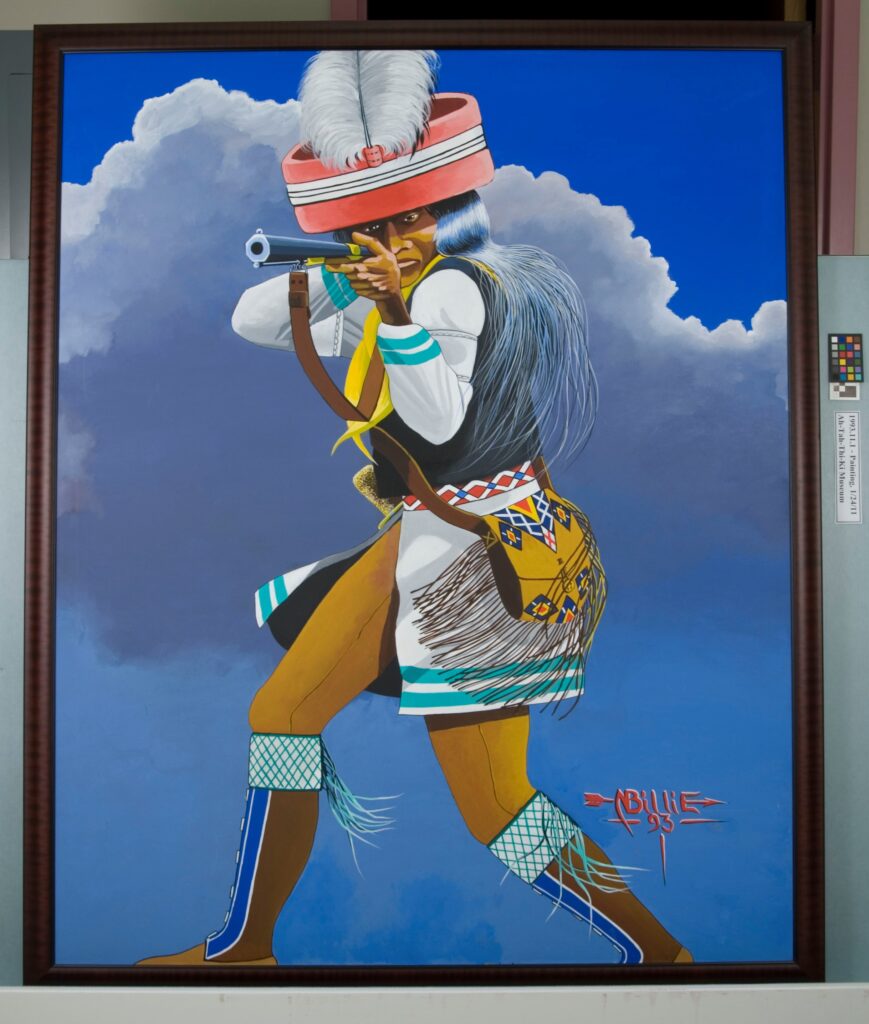
1993.11.1, ATTK Museum
Above, you can see the painting “Sam Jones Stand” by the late Seminole artist Noah Billie. Billie painted it in 1993, over 130 years after Sam Jones’ death. The painting depicts Sam Jones standing with a rifle directly pointed at the viewer. Jones is wearing traditional Seminole clothing, including a red turban with a plumed feather, leather-fringed bandolier bag, yellow handkerchief, white shirt, black vest, leather leggings, and green and white garters on top of tall moccasins.
Abiaka
Abiaka was a Miccosukee elder, talented medicine man, spiritual leader, and one of the most influential voices of the Seminole War period. Soldiers knew him as Sam Jones, a harmless old fisherman, or later “The Devil.” We have touched on the Seminole War period previously in a number of posts, including a recent piece on Egmont Key. For Seminoles, “there was only one war. They came under armed and organized attack from America in 1812, and the fighting only ended in 1858.” After the U.S. signed the Indian Removal Act of 1830, pressures on the Seminole became increasingly harsh. This resulted in the forced removal of tens of thousands of Indigenous peoples from their homelands. These included many Seminole and Miccosukee. As war became inevitable, it became apparent that resistance was the only option.
Abiaka was a fierce voice against removal, and he and his followers often used guerilla tactics in skirmishes with U.S. forces. He rallied warriors such as Coacoochee (Wild Cat) and Osceola to the cause. They would appear from seemingly nowhere, strike, then retreat into the swampland. Abiaka was often present at these battles, known for firing the first shot, guiding the battle, and tending to the wounded. Famously, he is quoted as saying “In Florida I was born. In Florida I will die. In Florida my bones shall bleach.” Throughout the entire war period, he would not waver from this. After the war, Abiaka would lead the remaining Seminole into the Everglades. He passed away in 1867, at his camp near the Big Cypress Swamp. Below, you can see the only known image of Abiaka. U.S. Army Doctor Ellis Hughes drew it in the late 1830s at Fort Lauderdale.
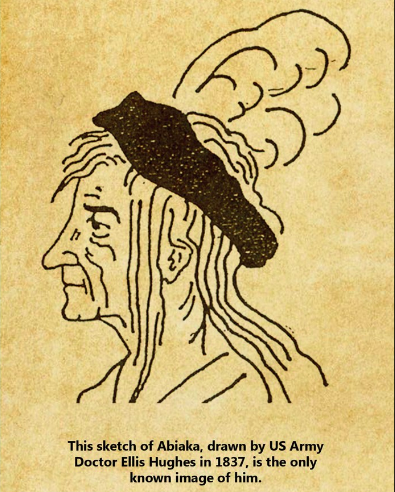
July 2022 Seminole History Stories, STOF THPO
Why Sam Jones?
So, why do we know Abiaka as Sam Jones? Abiaka sold fish to soldiers at Fort King, prior to outright war with U.S. forces. Seen as an eccentric old man, the soldiers soon began calling him Sam Jones, after the popular song of the time “Sam Jones the Fisherman.” When war became a reality, Abiaka played this Sam Jones role to his advantage. He would travel to various forts under the guise of selling fish, to spy and gather intelligence. As Florida’s military presence escalated, Sam Jones’ role in the Seminole resistance would become that of legend. In particular, historians credit Sam Jones with being a brilliant military strategist, even directing the Battle of Okeechobee in 1837.
In a 2014 editorial, James Billie addresses the story of Sam Jones, and why many don’t know him and his history. “There is an old Seminole saying: You do not repeat the name of the deceased,” Billie writes. “Maybe that is why he was never mentioned in our Tribe, or in the history passed down. Today that tradition has passed by. I hope no bad luck will come on me but my curiosity just got the best of me.” As he continues, he emphasizes that “I want the world to know about Sam Jones. I prefer Sam Jones over the many great leaders of our Tribe and the reason was that he lived and died in the country he loved and never surrendered.”
Without Sam Jones, the Seminole Tribe of Florida would likely not exist. Billie notes “Eight clans followed Sam Jones down here to escape the soldiers. Bird, Wind, Panther, Snake, Bear, Frog, Deer and Otter. Not all the clans followed Abiaki. Many were taken to Oklahoma. Raccoon, Sweet Potato, Long Hair Clan, none of them exist here anymore.”
The Devil
“That ol’ Devil,” James Billie writes, in the same 2014 editorial mentioned above, “It was almost a romantic term. You know: ‘That ol’ Devil escaped us again!’” The name became a legend. Soldiers describe Sam Jones as appearing and disappearing almost supernaturally, and evading U.S. forces with ease. Soldiers called him “The Devil” or “The Rascal.” Other stories described how “Abiaka would appear, and a war cry would be heard from an unknown location. Then he would disappear and the warriors would strike. This led many soldiers and settlers to believe that he had the ability to summon the creatures of the land in battle.”
“It is indeed interesting,” historian Patsy West writes, “that such an infamous person as Sam Jones, with his name bantered about around military campfires, in songs, poems, curses, and in the press throughout the country (a meme in his day), has until now rested in anonymity” (West 378).
With only the one single, poor, line drawing (above) to tell us what he looked like, his physical appearance also falls into legend. Even the physical descriptions of Sam Jones vary wildly, from a feeble old man to a supernatural warrior. Artist depictions reflect this variety. Notice the differences between the Noah Billie painting, Bradley Cooley’s bronze, and Guy LaBree’s painting below, depicting Jones and two others making their way through sawgrass.
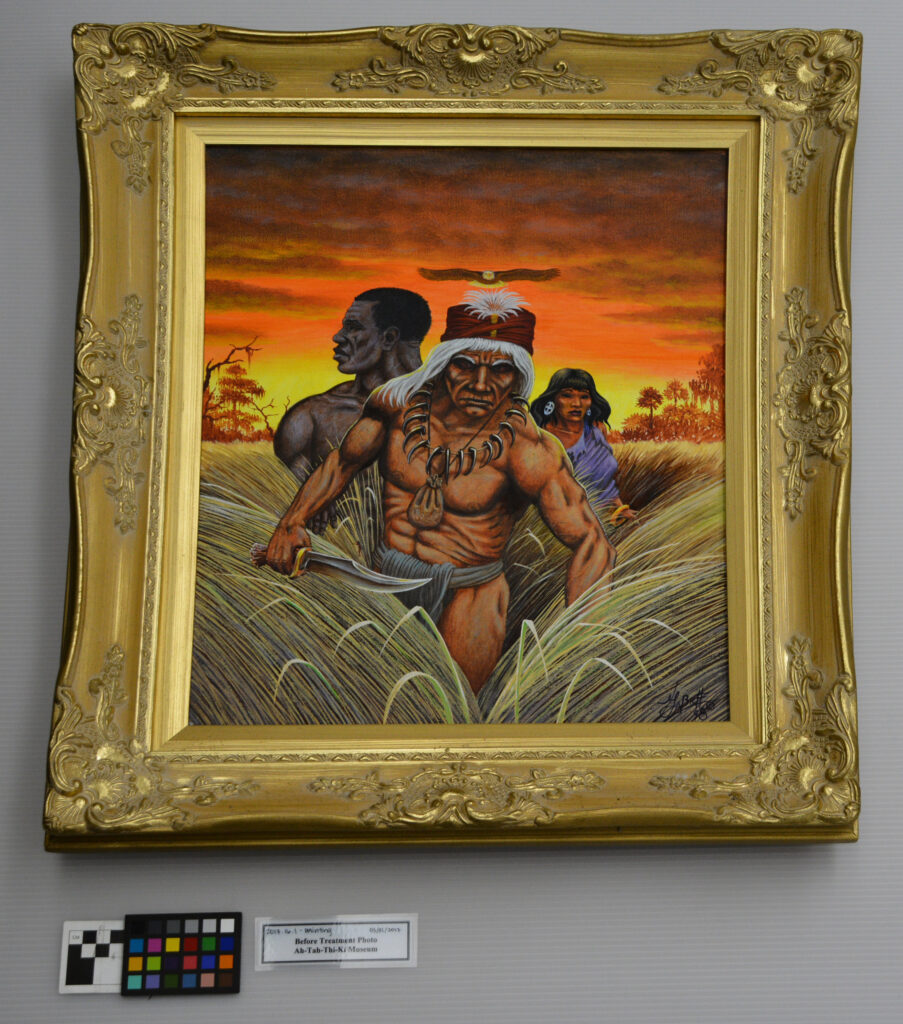
2017.16.1, ATTK Museum
The Devil’s Garden
Places and spaces attached to Sam Jones soon took on his name. Located just north of the Big Cypress Seminole Indian Reservation, the Devil’s Garden is one of the spaces. Sam Jones established a camp near what is now the Big Cypress Reservation and was known to have camps within the Everglades. James Billie explained that: “Sam Jones started it all back in the 1800s when he and his followers planted bananas, pumpkins, corn, sweet potatoes and other vegetables on fertile hammocks in this area. U.S. soldiers were on a mission to capture these Seminoles, and almost did. Surprised by the soldiers, the Seminoles ran off into the swamps, leaving their gardening tools behind. History tells us that one soldier, looking at the scene, declared, “This must be The Devil’s Garden.’” These hammocks were seemingly impenetrable by U.S. soldiers, and the area flourished with edible food.
The Devil’s Highway, Sam Jones Trail
In 2014, the Seminole Tribe of Florida’s Tribal Historic Preservation Office (STOF-THPO) began the process of renaming CR 833 “Sam Jones Trail.” They proposed that FDOT rename approximately 20 miles of CR 833 for Sam Jones, as it was his pathway that would eventually become the modern road.
In the formal proposal, former THPO research assistant David Brownell wrote that: “The uniqueness of the Sam Jones Trail is twofold. The trail is positioned to connect four watersheds that were crucial to the survival of the Seminoles and connected the different coasts of Florida…. In addition, the Devil’s Garden locale was so remote that the trail remained in its native, unpaved state far into the 20th century, used by Seminoles to move between camps and hunting areas, long after many other trails had been destroyed or forgotten by modern development.” In a 2014 Seminole Tribune article, Brownell would state that: “There are many historic references to Sam Jones in many places, never more than a mile or so from today’s road. It’s remarkable how closely the road matches the trail when we overlay their maps.”
Sam Jones Trail Today
Hendry County approved the proposal in 2015. The Seminole Tribe of Florida officially installed a marker honoring the change in 2019. Through years of research, the THPO proved that CR 833 almost exactly followed the mid-1800s path of Sam Jones.
Even more recently, the THPO featured the Sam Jones Trail in the 2023 THPO Big Cypress Historic Trails Story Map, created by THPO staff members Matthew Reyes, Juan Cancel, Dave Scheidecker and edited by J. Nicholas Butler. The Story Map notes that many historic Seminole trails “marked the best paths of travel” and were “developed as part of the modern Florida road system.” Additionally, the authors specifically point out Sam Jones Trail. “One of the prime examples is Sam Jones Trail,” they write, “a pathway used during the Seminole War, that was adapted as a significant portion of CR 833.” We encourage you to explore the Story Map and learn more about the historic Seminole Trails that have been important points of connection for the Seminole people. Below, you can see a screenshot from the Story Map. Sam Jones Trail is highlighted in bright blue.
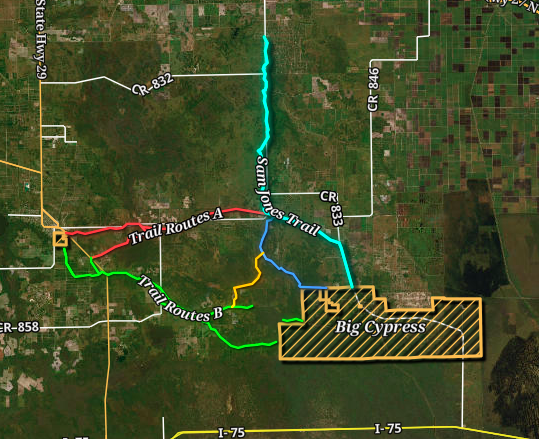
The Legacy of Sam Jones
Today, there are several statues around the state of Florida that honor Sam Jones. In 1995, Broward County unveiled a bronze statue in Tree Tops Park in Davie, Fl. At the dedication, Billy L. Cypress emphasized the importance of remembering the figure. He stated that: “People have forgotten about him….Sam Jones went through the calamity of the three Seminole wars and still stayed here” (Sept 16 1995, South Florida Sun Sentinel). The Tree Tops Park location was chosen for its proximity to the Pine Island Ridge. U.S. troops, under the direct of Major William Lauderdale, skirmished with Seminoles directed by Abiaka in 1838. The Sam Jones statue was counter to the William Lauderdale statue installed on the east side of the Pine Island Ridge in 1988. Additionally, Abiaka held a stronghold at the Pine Island Complex during the wartime period, tying him to the area (West 375).
An identical statue is located at the entrance of the Ah-Tah-Thi-Ki Museum, also by the Cooleys. The father-son duo were responsible for a number of bronze statues depicting Seminoles throughout the years, and Bradley Cooley Jr. continues the tradition. You can explore more statues by the Cooleys in the Ah-Tah-Thi-Ki Museum Sculpture Garden.
Sam Jones’ legacy lives on as one of the most important Seminole leaders of the wartime period. Although, many do not know his name. He was steadfast in his opposition to removal. “Starved, surrounded, sought with a vengeance, Sam Jones would answer no flag of truce, no offer of compromise, no demand of surrender. His final camp was in the Big Cypress Swamp, not far from the Seminole Tribe’s Big Cypress community of today” (as requoted in the 2016 article in Fort Lauderdale magazine, original source unknown).
Pumpkins of Devil’s Garden
Join the Ah-Tah-Thi-Ki Museum October 13, 2023 at 5pm for a special exhibit opening! For the second year in a row, the Ah-Tah-Thi-Ki Museum will be hosting Pumpkins of Devil’s Garden. Walk through the sculpture garden for glimpses of spooky and delightful pumpkins. Hear the Seminole Legend of the Devil’s Garden, enjoy Halloween treats, and wear your best family-friendly costumes! This year’s theme is “Heroes & Villains.” Arrive early for free admission to the Museum at 3pm, with the event beginning at 5pm.
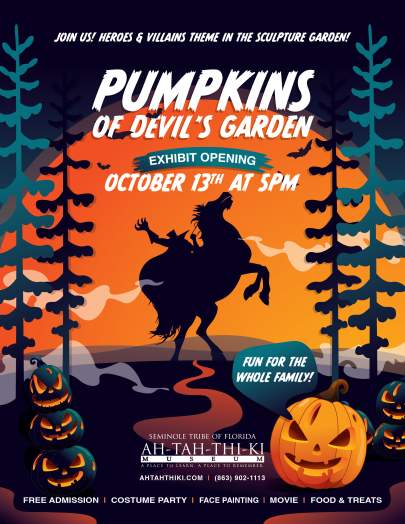
Additional Sources
The author accessed these sources digitally. Page reference numbers may not align with paper and hardback copies.
West, Patsy (2015) “Abiaka, or Sam Jones, in Context: The Mikasuki Ethnogenesis through the Third Seminole War,” Florida Historical Quarterly: Vol. 94: No. 3, Article 6. Available at: https://stars.library.ucf.edu/fhq/vol94/iss3/6
Author Bio
Originally from Washington state, Deanna Butler received her BA in Archaeological Sciences from the University of Washington in 2014. Deanna moved to South Florida in 2016. Soon, she began working for the Seminole Tribe of Florida’s Tribal Historic Preservation Office. Deanna was the THPO’s Archaeological Collections Assistant from 2017-2021. While at the THPO, Deanna worked to preserve, support, and process the Tribe’s archaeological collection. She often wrote the popular Artifact of the Month series, and worked on many community and educational outreach programs. She lives in Fort Myers, FL with her husband, son, and dog.


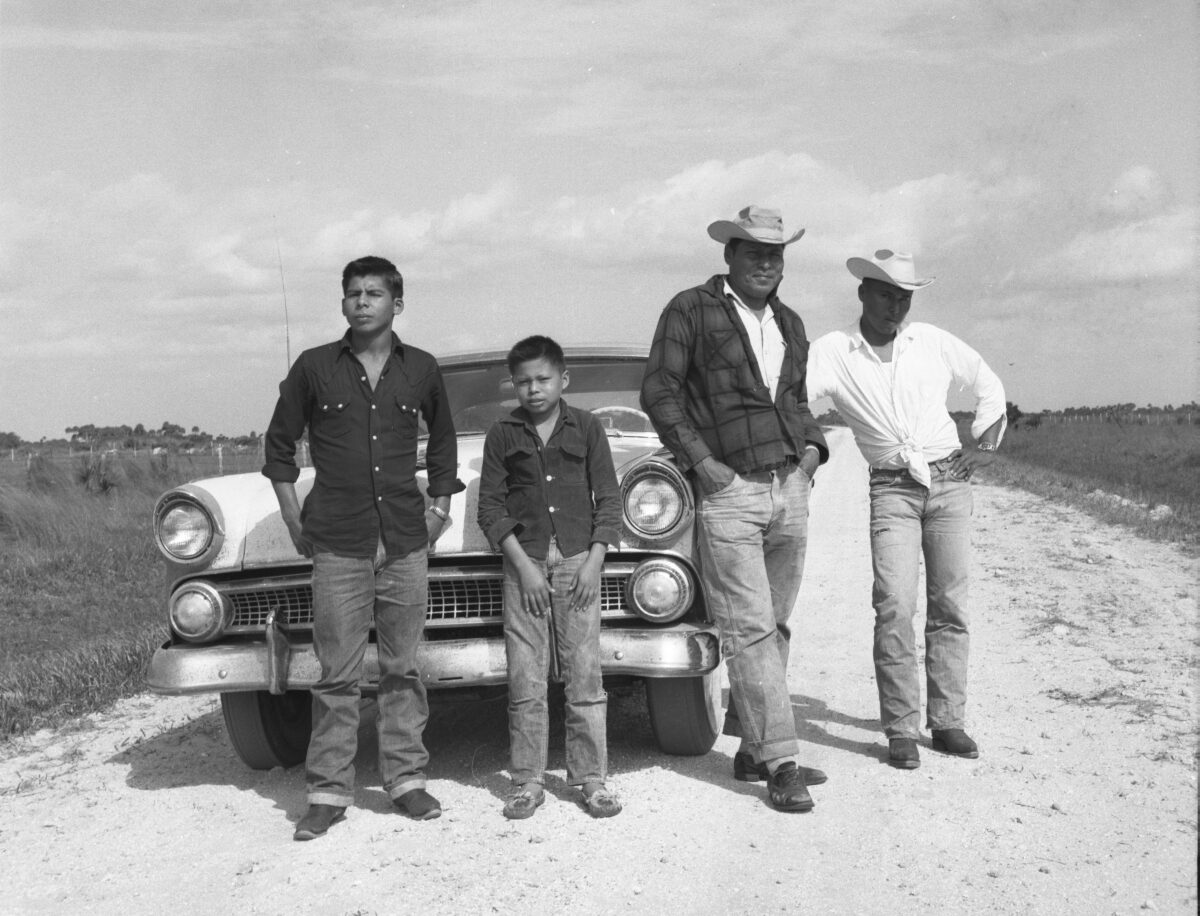

Pat
Tourism at Devil’s Garden? Seems idea for kids camp and retreats amidst the Seminole Indian legacy.